Operation Paul Bunyan - The Korean Axe Murders: Initial Attack
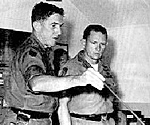
"Cut It Down!"
A day later, the US was demanding retribution for the attacks. At the time 2/9 Infantry (Manchu) was at the DMZ, and they were screaming the loudest, as Bonifas and Barrett were from their ranks. A plan was sent up to the Department of the Army for the 2nd Engineering Battalion to go into the JSA and forceably remove the tree. The one intangible was the reaction of the NKPA.
Intelligence suggested five possible responses:
- 1. No reaction, in which case the first echelon would cut down the tree and immediately evacuate the area
2. NKPA guards could put up minor resistance in the vicinity of the tree without using their weapons, in which case the men from A Company, 2/9 Infantry would quell the resistance with their pick axe handles, while the engineers cut down the tree and left.
3. The NKPA guards offered minor resistance, supported by ineffective gunfire. In this situation, the engineers might only be able to cut off one limb and leave the area, or the second echelon might be called in, with B and C Company of 2/9 Infantry, suppressing the gunfire to enable the engineers to cut the tree and then provide the supporting fires to enable the first echelon to break contact with the NKPA guards
4. The worse case, short of an all out engagement, was an effective exchange of gunfire, which would cause the commander to deploy his armor task force to evacuate the infantry elements already on the ground. Should this firing occur at the outset, the engineers might or might not be able to deploy; if it occurred while cutting the tree, the engineers might continue to work or might cease work immediately.
5. The reaction that no one wanted was an all-out engagement. The armor task force leveling the JSA and poplar tree, elements on the ground escaping and evading south to the Imjin River, and a possible evacuation of the 2nd Battalion 9th Infantry (Manchu) from Camp Greaves only a few short miles away.
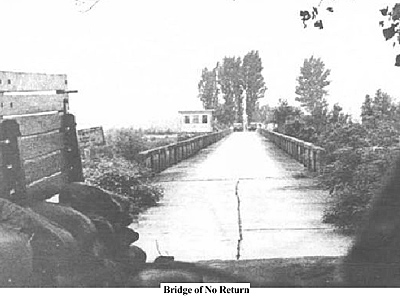 Preparations
Preparations
By Friday all of the preparations were set, including a Special Forces detachment from the ROK 1st Infantry Division. Second Lieutenant Jim Kulick, the 2/9 Infantry battalion support platoon leader, was ordered to have the quick reaction force on the trucks, armed and ready. The startled Kulick, asked for confirmation. “You want me to take the TOW missiles out of the box?”
Within the next few hours every man in the 2/9 Infantry had his basic load of ammunition, all his individual gear, and was ready to move out. Unknown to the majority of the leaders in 2ID, and all of the 2/9 Infantry, the Navy and Air Force had also scrambled resources should a war break out. A squadron of F-111’s from Mountain Home Air Force Base, Idaho and another of F-4s from Okinawa was sent to Osan Airbase, Korea, Two B-52 bombers were diverted from their bases in Okinawa to perform training missions over Korea. Elements of the Seventh Fleet, along with the carrier USS Midway, steamed towards Korea. The Fifth Air Force in Okinawa was placed on increased readiness. On the ground the 38th Air Defense Artillery went on full readiness, and set up two tactical air control centers in Taegu, and Osan.
On the night of Friday, Augst 20th, Captain Berry Robinson II, commander of Company C 2/9 Infantry gathered his men together, and briefed them of the next day’s events “Men, we are going in to the Panmunjom by Hueys and killing anything that moves. Company B is going to take one half and we are going to take the other half.” Morale was high.
A few hours earlier the United Nations Forces had won a political argument in the Military Armistice Committee meeting, defaming the North Koreans as “savage.” During the initial statements, Admiral Mark Frudden stated, “These actions have been exposed as actions of animals. Not only the UNC but the civilized people of the entire world will watch you closely to see that you punish the murderers.” During his statement, Frudden displayed pictures of the attack that clearly showed that the NKPA had started the incident. NKPA Major Han Chu Gyong claimed that it was the UNC personnel’s provocation that caused the attack, and showed one axe stained with the blood of a North Korean guard. However, in the one hour and forty minute meeting, there was no change in the atmosphere from the first opening words. There was no name-calling, or long tirades by the Democratic Peoples Republic of Korea (DPRK). The entire DPRK delegation seemed to be in physical discomfort, as their countercharges seemed to fall flat to the charges brought by the UNC.
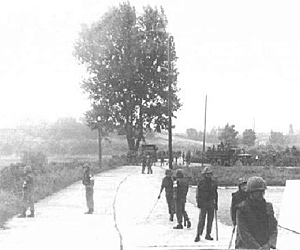 The Tree
The Tree
As soon as the engineer battalion was given the description of Operation Paul Bunyan, named for the folklore hero who could cut a tree with a single blow, the engineers insisted on pictures of the tree. During the Japanese occupation of Korea during World War II, many of the trees had been removed to help fuel the Japanese war machine. And almost all of the trees that had survived World War II were crushed in the mass artillery barrages that happened during the Korean War. In fact if you look closely at the trees in Korea, even today, you can see they all match-up on a grid. The engineer battalion was hoping for one of the newly planted trees. Finally when a postcard was found that had a picture of poplar tree up at Panmunjom, the engineers were amazed. The poplar tree had survived not only the Korean War, and World War II, but was probably a few centuries old. The poplar tree up at the DMZ, was almost four feet in diameter.
The original plan had called for the engineers to strap explosives to it, and destroy it. After a few calculations it was discovered that to thoroughly remove the tree would require fifty pounds of TNT, which has a safety zone of 1,000 feet. Obviously this would not work at the JSA, and a new plan was quickly devised, to go in and cut the tree down with conventional axes, and chain saws.
On Saturday August 21st at 0600 the UNC commander handed a small note to his North Korean counter-part which read “At 0700 a UNC detail will enter the Joint Security Area to complete the tree trimming task that was interrupted a few days prior. If there is no interruption they will leave the area as soon as they are done.”
By 0630 all units had been mobilized, both companies, Bravo (B) and Charlie (C) of 2/9 Infantry, had boarded twenty helicopters that took their orbit around the tree. The 1/72 Armored Battalion was parked on the final road to the JSA. All of the artillery units had moved to their forward artillery position, and aimed their sights in the direction of Panmunjom. The B-52’s from Okinawa were just arriving in the Korean airspace, the F-111’s were scrambled, and the Seventh Fleet was on full alert.
At 0700 the men from A 2/9 (Manchu) entered the JSA armed with ax handles. The Special Forces Detachment of the 1st ROK Division, garbed in the Korean Service Corp. (KSC) uniforms, formed a ring around the tree, and the engineers began to cut the tree. One can only image what the North Koreans thought as they saw an entire company of men arrived in 2 ½ ton trucks, and watched the engineers begin to cut into the tree, that they were told was nurtured by Kim Il Sung’s son.
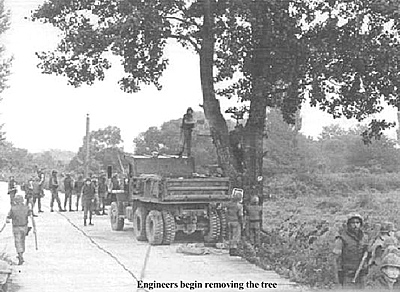 By 0718 the first limb had been removed from the tree, coming down with great cheers from the men in the area. Shortly there after, one of the illegal checkpoints that the NKPA had set-up was also destroyed, as the ROK Special Forces finished pulling it from the earth. Sergeant First Class George Pruiett, the platoon sergeant in charge of cutting the tree, had told his men to bring in all thirteen of the chainsaws to cut the four foot wide poplar tree. Unfortunately, because the tree main branches of the tree stuck off of the trunk at an odd angle, the engineers found it hard to get a good position to cut. Some had to stand on top of their 2-½ ton truck, to get the proper heightand leverage to use the chainsaws.
By 0718 the first limb had been removed from the tree, coming down with great cheers from the men in the area. Shortly there after, one of the illegal checkpoints that the NKPA had set-up was also destroyed, as the ROK Special Forces finished pulling it from the earth. Sergeant First Class George Pruiett, the platoon sergeant in charge of cutting the tree, had told his men to bring in all thirteen of the chainsaws to cut the four foot wide poplar tree. Unfortunately, because the tree main branches of the tree stuck off of the trunk at an odd angle, the engineers found it hard to get a good position to cut. Some had to stand on top of their 2-½ ton truck, to get the proper heightand leverage to use the chainsaws.
Initially, all the chainsaw wielders were being used to cut into the wood. The buzz of the saws sounding like an angelic chorus to the security patrols at Panmunjom. After the first few minutes of cutting, however, first one chainsaw, then a second stopped cutting, and finally the third quit. The men of Alpha 2/9 Infantry, looked back, wondering why the cutting had stopped. Had Major General Morris J. Brady, the 2ID commander watching from the air, given the order to halt.
While everyone was wondering why the tree cutting process had stopped, the following transmission came over the radio:
“K16 (Lieutenant Colonel Vierra commander of the MANCHU), this is K26 (one of the JSA security platoon leaders). Our unarmed allies have hand grenades with them –over.”
Vierra: “You tell those allies to give them to you – OUT”
Several minutes later:
“K16, the allies will not give us their hand grenades –over.
“This is K16. You tell them to give –break- you tell them not to use the grenades.” [1]
By 0745 the tree had been taken down, and had required all thirteen of the chainsaws.
Back at Camp Liberty Bell, Major Mack Willis was relaying information to the Eighth Army headquarters in Seoul, about what was going on in the DMZ. Eighth Army wanted to know how many people had gone into the JSA. Willis answered quickly: the 16 man work force, 30 man security team armed with axe handles and side arms (The only weapons allowed to be in the JSA).
When he was asked about the tree, all he could say for sure was that it was a poplar, and when they asked for its age, Willis was unable to answer. In true headquarters fashion, Eighth Army told Willis to count the rings, but finally accepted first response.
Once the final limb fell, and the last of the illegal checkpoints were pulled up, the ROK Special Forces moved back to the security perimeter. Alpha 2/9 Infantry, then double-timed to the Bridge of No Return shouting “MANCU MANCHU, KEEP UP THE FIRE!” which unnerved the North Korean guards.
By 0745, the entire US force was preparing to move out of the JSA. The ROK Special Forces still held their ground. When Vierra told the ROK Special Forces to move, the KATUSA (Korean Augmented to the US Army) informed Vierra that the ROK Special Forces said they were not moving. Vierra called General Brady for instructions and was told to pull his men back to Camp Liberty Bell. Brady then ordered his Assistant Division Commander (Maneuver), Brigadier General Louis Mentrey, to directly order the ROK Special Forces out of the area.
It turned out that Vierra’s translation had been inaccurate. The Special Forces had actually said that that they weren’t leaving, until everyone else had left. The ROK Special Forces knew they were the only hope of a meaningful resistance should the North Koreans attack, and were not about to leave their brothers in arms out to dry. When the units arrived back at Camp Liberty Bell, they were congratulated on a mission well done. The operation had proven to the NKPA that no matter what they did, the UNC would maintain the right of movement in the JSA.
On the other side of the border, the North Korean press reported the incident in a completely different light, saying “The US imperialist had herded over three-hundred armed hooligans into the Joint Security Area and had them cut down the tree, demolish our side’s guard posts, and destroy the roadblock at our checkpoint, committing ferocious outrages. The gangsters were protected in their hostilities by B-52 strategic bombers, jet planes and helicopters.” According to the report, “The objective of the tree-cutting mission was (1) to renew aggressive war, (2) save themselves from crises inside and outside, (3) for President Ford to bolster up his damaged prestige and scrape more votes in the elections to regain the post of presidency, and (4) save the danger of ruin for the Park Chung Hee puppet clique."
It continued on to say, “The US Imperialist Aggressors must stop at once their criminal new war plots, look at the stark realities, and act with discretion, and leave South Korea without delay, taking all lethal weapons and aggressive forces with them. No force on earth can halt the vigorous advance of our people rallied firmly around the great leader and the glorious party center.” [2]
For the next few years the remains of the tree, a mangled stump of wood standing about six feet, shone like a beacon into North Korea. It warned them to use care and caution the next time they hoped to harass the UNC. It also stood, as a caution to the North Koreans, that no matter how big they thought they were, the Republic of Korea, and the United States were not afraid of them. After the North Koreans finally abandoned their checkpoint across from Checkpoint Three,and after being told that they could no longer use the ‘Bridge of No Return,’ the tree was finally fully pulled down.
Inside the “Monastery” at Camp KittyHawk (renamed Camp Bonifas in 1986), only a few short minutes away, one can find a wooden display box. Inside sits the arm bands of Captain Bonifas and Lieutenant Barrett. Also inside of the box is a picture of the mangled tree, and a small display card. The card reads;
The badges read “Badge #9 Maj. Bonifas “Bonifas,” and Badge #12 1LT. Barrett “Big Bear” The rest of the tree’s limbs were carved into walking sticks and given to the commanders of each of the battalions that played a signifigant role in Operation Paul Bunyan. There is also a stump, about a foot high at the Camp Red Cloud Second Infantry Division Museum, in Uijongbu Korea.
Since 1953, when the Korean War was ‘ended,’ there have been over 20,000 infractions of the Armistice by the North Koreans. Almost all of these have gone unreported, or at least unnoticed in the United States. Most recently, the North Koreans have fired upon Republic of Korea ships in the sea of Japan, and in the past few months, have fired upon Joint Security Area checkpoints with machine gun fire. For the past fifty years, the United States has thought that the Korean War was over, but it's not. It may never be over.
Operation Paul Bunyan - The Korean Axe Murders: Initial Attack
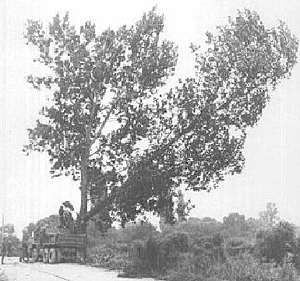 ‘Three Hundred Armed Hooligans…’
‘Three Hundred Armed Hooligans…’
 Now, when you look out from the UNC building, and look towards Checkpoint Three and the ‘Bridge,’ all one can see is a marble column standing about three feet. It reads “On this spot was located the yellow poplar tree which was the focal point of the Ax Murders of the two United Nations Command officers, Captain Arthur Bonifas, and 1LT Mark Barrett, who were attacked and killed by the North Korean guards while supervising a work party trimming the tree”.
Now, when you look out from the UNC building, and look towards Checkpoint Three and the ‘Bridge,’ all one can see is a marble column standing about three feet. It reads “On this spot was located the yellow poplar tree which was the focal point of the Ax Murders of the two United Nations Command officers, Captain Arthur Bonifas, and 1LT Mark Barrett, who were attacked and killed by the North Korean guards while supervising a work party trimming the tree”.
To Memorialize Maj. (He was posthumously promoted) Arthur G. Bonifas and 1LT Mark T. Barrett killed in action, 18 August 1976, Panmunjom, Korea. These hats represent their everlasting presence for duty in this unit, These badges, never to be worn again, rest here in recognition of the vigil these two soldiers keep, even in death. This wood, a piece of the tree that no longer stands, commemorate the resolve of two nations, and courage of a few soldiers who will always remember, who can never forget, but who must not look back.”
Operation Paul Bunyan: Eyewitness Account of the Deaths of Bonifas and Barrett by
Back to Cry Havoc! #44 Table of Contents
Back to Cry Havoc! List of Issues
Back to MagWeb Master Magazine List
© Copyright 2003 by David W. Tschanz.
This article appears in MagWeb.com (Magazine Web) on the Internet World Wide Web. Other articles from military history and related magazines are available at http://www.magweb.com